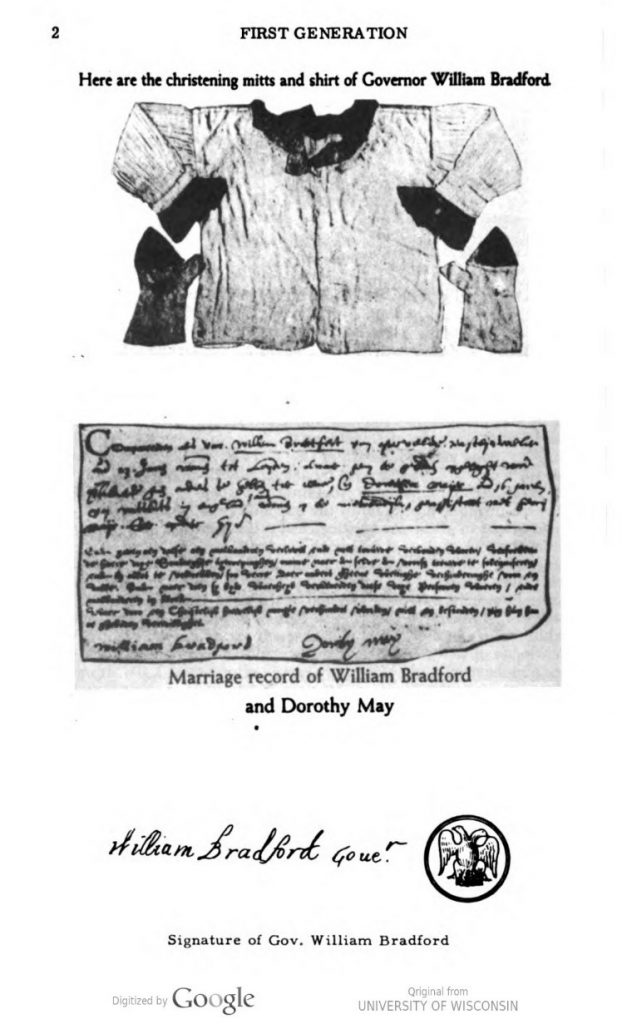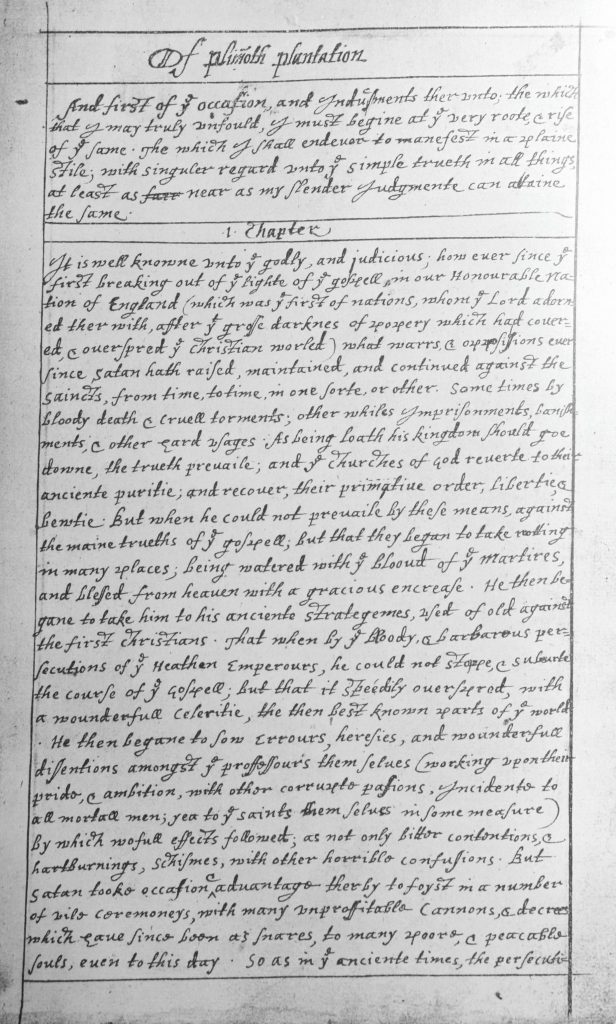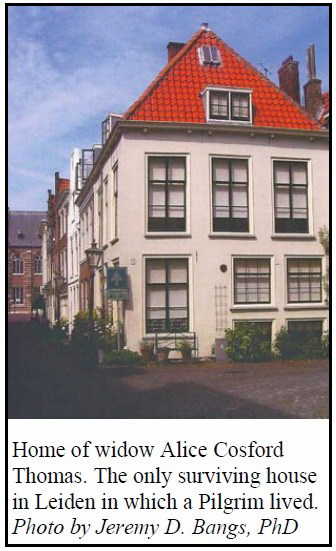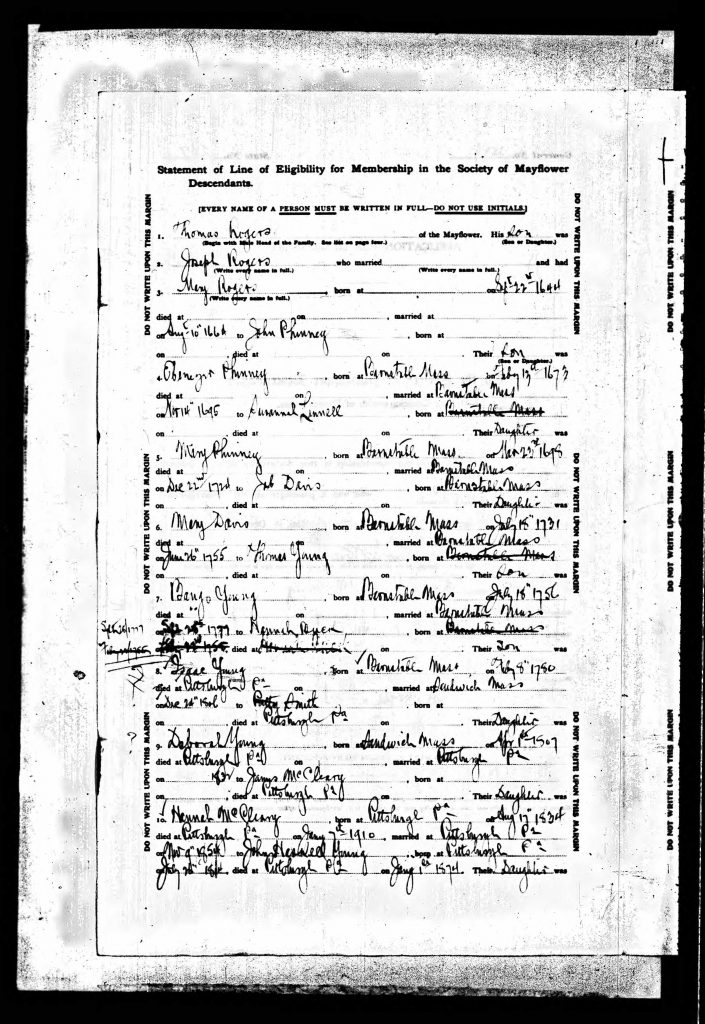
William Bradford


William Bradford (1590-1657) Alice Carpenter (1593-1670)
We are descended from 3 of the 102 passengers that arrived in Plymouth Harbor in 1620. William Bradford became the colony’s leader. We are descended from Bradford through Daniel H. Wells on the Andrew side of the family. We are also descended from Thomas Rogers and his son Joseph through Electa England on the Fike side. There are a lot of resources available online to learn about the Mayflower story and passengers, so I won’t reproduce much of it here. I invite you to learn more and to visit the Plymouth, Massachusetts museums and other sites in the area.
William Bradford was born to Alice Briggs and William Bradford in Austerfield, West Riding of Yorkshire, and was baptized on March 19, 1589/90. The family possessed a large farm and were considered wealthy and influential in a time when most of their countrymen were farmers of modest means.
When Bradford was 12 years old, a friend invited him to hear the Rev. Richard Clyfton preach 10 miles away in All Saints’ Church, Babworth in Nottinghamshire. Clyfton believed that the Church of England ought to eliminate all vestiges of Roman Catholic practices, and that this would result in a purer Christian church. During one meeting, Bradford met William Brewster, a bailiff and postmaster who lived at Scrooby manor, four miles from Austerfield. During frequent visits, Bradford borrowed books from him, and Brewster regaled him with stories of the efforts toward church reform taking place throughout England.
The Scrooby congregation decided in 1607 to leave England unlawfully for the Dutch Republic, where religious freedom was permitted, and Bradford determined to go with them. By the summer of 1608, however, they managed to escape England in small groups and relocate to Leiden in the Dutch Republic. Bradford was 18.
Bradford arrived in Amsterdam in August 1608. He had no family with him and was taken in by the Brewster household. After nine months, the group chose to relocate to the smaller city of Leiden.
Bradford continued to reside with the Brewster family in a poor Leiden neighborhood known as Stink Alley. Conditions changed dramatically for him when he turned 21 and was able to claim his family inheritance in 1611. He bought his own house, set up a workshop as a fustian weaver (weaver of heavy cotton cloth for men’s clothing), and earned a reputable standing. In 1613, he married Dorothy May, the daughter of a well-off English couple living in Amsterdam. They were married in a civil service, as they could find no example of a religious service in the Scriptures.
In 1619, William Bradford sold his house in Leiden and appears in March 1620 tax records in London being taxed for personal property at the Duke’s Place, Aldgate. Aldgate was an area of London known to be the residence of numerous Dutch merchants, as well as many religious dissenters. Some familiar Mayflower names of families living in the area included Allerton, Tilley, Sampson, and Hopkins.
By 1617, the Scrooby congregation began to plan the establishment of their own colony in the Americas. The Separatists could practice religion as they pleased in the Dutch Republic, but they were troubled by the fact that their children were being influenced by Dutch customs and language, after nearly ten years in the Netherlands. Therefore, they commenced three years of difficult negotiations in England seeking permission to settle in the northern parts of the Colony of Virginia (which then extended north to the Hudson River). The colonists also struggled to negotiate terms with a group of financial backers in London known as the Merchant Adventurers. By July 1620, Robert Cushman and John Carver had made the necessary arrangements, and approximately fifty Separatists departed Delftshaven on board the Speedwell.
It was an emotional departure. Many families were split, as some Separatists stayed behind in the Netherlands, planning to make the voyage to the New World after the colony had been established. William and Dorothy Bradford left their three-year-old son John with Dorothy’s parents in Amsterdam, possibly because he was too frail to make the voyage.
The Mayflower departed Plymouth, England on September 6/16, 1620. The 100-foot ship had 102 passengers and a crew of 30 – 40 in extremely cramped conditions. There were two deaths on the trip, a crew member and a passenger.
They spotted Cape Cod hook on November 9/19, 1620, after about a month of delays in England and two months at sea. They spent several days trying to get south to their planned destination of the Colony of Virginia, but strong winter seas forced them to return to the harbor at Cape Cod hook, now called Provincetown Harbor, where they anchored on November 11/21, 1620. The Mayflower Compact was signed that day, Bradford being one of the first to sign.
Bradford had yet to assume any significant leadership role in the colony by the time that he was 30. The Mayflower anchored in Provincetown Harbor and he volunteered to be a member of the exploration parties searching for a place for settlement. In November and December, these parties made three separate ventures from the Mayflower on foot and by boat, finally locating Plymouth Harbor in mid-December and selecting that site for settlement.
During the first expedition on foot, Bradford got caught in a deer trap made by Indians and hauled nearly upside down. The third exploration departed from the Mayflower on December 6, 1620 when a group of men (including Bradford) located Plymouth Bay. A winter storm nearly sank their boat as they approached the bay, but they managed to land on Clark’s Island, suffering from severe exposure to the cold and waves. During the ensuing days, they explored the bay and found a suitable place for settlement, now the site of downtown Plymouth, Massachusetts. The location featured a prominent hill ideal for a defensive fort. There were numerous brooks providing fresh water, and it had been the location of an Indian village known as Patuxet; therefore, much of the area had already been cleared for planting crops. The Patuxet tribe had been wiped out by plagues between 1616 and 1619, possibly as a result of contact with English fishermen or from contact with the French to the north. Bradford wrote that bones of the dead were clearly evident in many places.
When the exploring party made their way back on board, he learned of the death of his wife Dorothy. Dorothy (May) Bradford fell overboard off the deck of the Mayflower during his absence and drowned. Bradford married Alice (Carpenter) Southworth in 1623, with whom he had three children. We are descended from Alice.
The Mayflower arrived in Plymouth Bay on December 20, 1620. The settlers began building the colony’s first house on December 25 (Christmas). Their efforts were slowed, however, when a widespread sickness struck the settlers. The sickness had begun on the ship. On January 11, 1621, Bradford was helping to build houses when he was suddenly struck with great pain in his hipbone and collapsed. He was taken to the “common house” (the only finished house built then) and it was feared that he would not last the night.
Bradford recovered, but many of the other settlers were not so fortunate. During the months of February and March 1621, sometimes two or three people died a day. By the end of the winter, half of the 100 settlers had died. In an attempt to hide their weakness from Native Americans who might be watching them, the settlers buried their dead in unmarked graves on Cole’s Hill, often at night, and made efforts to conceal the burials.
In April 1621, Governor Carver collapsed while working in the fields on a hot day. He died a few days later. The settlers of Plymouth then chose Bradford as the new governor, a position which he retained off and on for the rest of his life.
William Bradford’s most well-known literary work by far is “Of Plymouth Plantation”. It is a detailed history in journal form about the founding of the Plymouth Colony and the lives of the colonists from 1621 to 1646. The first part of the work was written in 1630; toward the end of his life, he updated it to provide “the account of the colony’s struggles and achievements through the year 1646.” Bradford drew deep parallels between everyday life and the events of the Bible. As Philip Gould writes, “Bradford hoped to demonstrate the workings of divine providence for the edification of future generations”.
(excerpted from a Wikipedia article)



Thomas and Joseph Rogers
Our 11th Great-Grandfather Thomas Rogers also came to The New World on “The Mayflower” in 1620 with his eldest son Joseph Rogers.
Thomas was a signatory to the Mayflower Compact but died in the winter of 1620/21. His son Joseph, who traveled with Thomas on the Mayflower, but was too young, at age 17, to sign the Mayflower Compact but survived to live a long life.
Thomas Rogers was born in the village of Watford, in Northamptonshire, England about 1571. He married Alice Cosford in Watford parish October 24, 1597, with their six children being baptized there between 1598 and 1613. The family went to Leiden with other members of the English Separatist church sometime after their last child, Margaret, was baptized in 1613.
The earliest Leiden record for Thomas Rogers notes that on February 14, 1614 he bought a house on Barabarasteeg from Jan Bloemsaer, a baker. Leiden records also notes that Rogers became a citizen of Leiden on June 25, 1618. That record states that he was a merchant of camlet, a luxury Asian-type fabric made from a combination of silk and camel’s hair.
Thomas Rogers traveled on the Mayflower with only his eldest son Joseph (our ancestor), leaving behind in Leiden his wife and their three other children – John, Elizabeth and Margaret. In the 1622 poll tax for Leiden, Rogers’ family were found among the poor of Leiden, residing at the rear of Anthony Clement’s home. His possible second wife, who author Eugene Stratton lists as Elizabeth (or Elsgen) in the 1622 poll tax, may have died in Leiden sometime between 1622 and when his son John and daughters came to Plymouth sometime after 1627.

William Bradford’s later recollection of Thomas Rogers and his son embarked on the Mayflower: “Thomas Rogers, and Joseph, his sone. His other children came afterwards.”
Thomas Rogers and his 18-year-old son Joseph departed Plymouth, England aboard the Mayflower on September 6/16, 1620. On November 9/19, 1620, after about three months at sea, including a month of delays in England, they spotted land, which was the Cape Cod Hook, now called Provincetown Harbor. After several days of trying to get south to their planned destination of the Colony of Virginia, strong winter seas forced them to return to the harbor at Cape Cod hook, where they anchored on November 11/21. The Mayflower Compact was signed that day.
Thomas Rogers was the 18th signatory to the Mayflower Compact. His son Joseph was then about 18 years of age and could not sign the Compact.
Thomas Rogers died sometime during the first winter in Plymouth. His son Joseph survived and may have lived with Governor Bradford and family.
William Bradford’s 1651 recollection of the fate of Thomas Rogers and his family: “Thomas Rogers dyed in the first sickness, but his son Joseph is still living, and is married, and hath 6 children. The rest of Thomas Rogers (children) came over, and are married, and have many children.”
Thomas Rogers was buried, likely in an unmarked grave as with most Mayflower passengers who died in the first winter, in Coles Hill Burial Ground in Plymouth. The name of Thomas Rogers is memorialized on the Pilgrim Memorial Tomb on Coles Hill.
Joseph Rogers. Baptized January 23, 1602 and came to Plymouth on the Mayflower with his father in 1620. He married in New England and had eight children, most born in Duxbury. A wife “Hannah” is mentioned in his will, but it is not known when they married or if she is the mother of his children. He died in Nauset, now Eastham, on January 15, 1678, and was buried in Old Cove Burial Ground there.
Joseph Rogers was a notable person in Plymouth Colony. Over the years, he was involved in the founding of Bridgewater and Eastham. His name appears in the following colony records: 1623 Division of Land with Wm. Brewster – in the 1623 Plymouth Colony land division, Joseph Rogers was allotted two acres – one for himself and one on behalf of his late father; 1626 Purchasers list (colony investors); 1627 Division of Cattle with Wm. Bradford; 1633-34 Tax Lists – with his brother John on the 1633 list along with being a freeman that year; 1643 Able to Bear Arms List (with his brother John – with his surname given as “Roger”). In 1658 he was on the War Council of Plymouth Colony.
